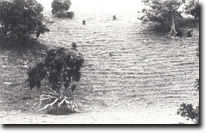Mass Movement Process in the South Gippsland Hills - Landslips and Soil Creep.
|
This information has been developed from the publications:
|
| Introduction: | Despite the extensive clearing of the original forest vegetation, there is little obvious evidence of accelerated slope erosion in the form of sheetwash fans, rilling or extensive gullying over much of the South Gippsland hill country. Dissection of floodplain deposits and alluvial fans has caused some deep gullies to develop on the margins of the South Gippsland Hills, but the most widespread mass movement processes are soil creep and slumping. Soil creep is almost a universal phenomenon on steep hillslopes on Cretaceous sediments in South Gippsland, and is expressed as rows of large, angular terracettes. They are present particularly where there is intensive sheep grazing, but the detailed pattern of their distribution is complex. Studies of the origin and dynamics of terracettes would require analysis of their distribution in relation to several factors, e.g. lithology, soil, slope and land use. Because of their widespread distribution, no particular terracette site has been selected as one of significance. Landslips, typically rotational slides, have modified the slope form and drainage pattern in certain areas of the South Gippsland hills. The areas most acceptable to rapid mass movement are those where Tertiary sediments or volcanics lie as cappings on hilltops over the Cretaceous rocks. Failure usually occurs in the weathered volcanics or in the unconsolidated or poorly consolidated sediments beneath the basalt, e.g. the Childers Formation. This failure is along a curved shear plane causing a sinking at the head of the slide exposing a steep headwall scarp. The toe of the slide may be heaved upwards causing some backtilt of the original surface. Below this, the material may fail further by earthflow, and a complex fractured surface may result. This fractured earth material may flow into and across stream channels causing temporary damming or minor diversion of the stream flow. Minor tunnelling and gullying may develop on this lower disturbed surface. | |
Significance and Management of Landslip Areas: | Landslips and other forms of mass movement may pose a substantial threat to property in parts of South Gippsland. Detailed land capability studies are necessary to determine areas of potential landslide risk, and changes in land use or constraints on areas where there is evidence of prior landslip activity should not proceed with out analysis of the mass movement hazard. Study of existing landslips to determine factors involved in their development means that some landslips need to be regarded as reference sites and warrant their management as sites of significance. Thus, where minimal threat or damage to property is involved, there is a case to be made for retaining some landslips as active and continuing features. Also the exposures of underlying material that is displayed in the headwall scarp may be some of the few outcrops of that material available. The mass movement sites described in this report are regarded as meeting sufficient criteria to be classified as site of geomorphological significance. | |
 Terracettes on steep slopes developed on Cretaceous sidemints. |


